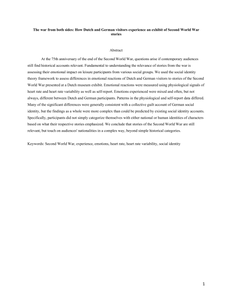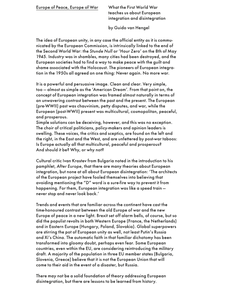At the 75th anniversary of the end of the Second World War, questions arise if contemporary audiences still find historical accounts relevant. Fundamental to understanding the relevance of stories from the war is assessing their emotional impact on leisure participants from various social groups. We used the social identity theory framework to assess differences in emotional reactions of Dutch and German visitors to stories of the Second World War presented at a Dutch museum exhibit. Emotional reactions were measured using physiological signals of heart rate and heart rate variability as well as self-report. Emotions experienced were mixed and often, but not always, different between Dutch and German participants. Patterns in the physiological and self-report data differed. Many of the significant differences were generally consistent with a collective guilt account of German social identity, but the findings as a whole were more complex than could be predicted by existing social identity accounts. Specifically, participants did not simply categorize themselves with either national or human identities of characters based on what their respective stories emphasized. We conclude that stories of the Second World War are still relevant, but touch on audiences’ nationalities in a complex way, beyond simple historical categories.
DOCUMENT

The idea of European unity, in any case the official entity as it is communicated by the European Commission, is intrinsically linked to the end of the Second World War: the Stunde Null or 'Hour Zero' on the 8th of May 1945. Industry was in shambles, many cities had been destroyed, and the European societies had to find a way to make peace with the guilt and shame associated with the Holocaust. The pioneers of European integration in the 1950s all agreed on one thing: Never again. No more war. It is a powerful and persuasive image. Clean and clear. Very simple, too - almost as simple as the 'American Dream'. From that point on, the concept of European integration was framed almost naturally in terms of an unwavering contrast between the past and the present. The European {pre-WWII) past was chauvinism, petty disputes, and war, while the European {post-WWII) present was multicultural, cosmopolitan, peaceful, and prosperous. Simple solutions can be deceiving, however, and this was no exception. The choir of critical politicians, policy-makers and opinion leaders is swelling. These voices, the critics and sceptics, are found on the left and the right, in the East and the West, and are unfettered by post-war taboos: Is Europe actually all that multicultural, peaceful and prosperous? And should it be? Why, or why not? LinkedIn: https://www.linkedin.com/in/guido-van-hengel-8312729/
DOCUMENT

Many, many comparisons have been drawn in recent years between the current rise of (right-wing) populism and the financial crisis of 2008 that shook and continues to shake Europe to its core, and the tumultuous and horrifying events of the 1930s, which in the end resulted in the Second World War. A number of recent studies which (partially) focus on this decade carry ominous titles like To Hell and Back, The Age of Catastrophe and The Triumph of the Dark. Referred to by some historians as the second Thirty Years’ War, the period from the First World War to the end of the Second still continues to draw much academic and indeed public attention. In many cases, Germany deservedly plays a central role in the analysis, either in the form of the Kaiserreich or the ill-fated Weimar Republic and, of course, Nazi Germany. The five books under review here discuss European history between 1914 and 1950 in general, and that of Germany in particular, in this period. What do these books tell us about Europe’s and Germany’s path in the first half of the twentieth century, and what new insights do they provide? https://doi.org/10.1177/0265691418777981 LinkedIn: https://www.linkedin.com/in/martijn-lak-71793013/
MULTIFILE

DOCUMENT
Exhibition of Work In Progress outcomes of elective course 'Mythbusters, Unfixing Histories, World Press Photo'. The course is part of the project Unfixing Histories, which is related to my PhD research, but takes the gesture of investigating histories in and with photographs as part of artistic practices to other contexts. In this case students investigate in different ways one World Press Photo winner of their choice. Final results will be presented during "Unfixing Histoires" at Platform Minerva, March/April 2018. This exhibition is part of the World Press Photo Groningen exhibition in the Synagogue in Groningen.
DOCUMENT

The COVID-19 global pandemic has raised once more the spectre of world governance, demonstrating in one fell swoop, the intricate entanglement of nation-states and the challenges they face when confronted with a global threat. The pandemic has produced an array of problems, from the deaths of millions, the desecration of health care systems all over the world, to the disruption of the economic and social lives of most of the worlds citizens and the emergence of vaccine politics. While not addressing the pandemic directly, this dossier examines the pandemic moment as both an opportunity and a crisis for the UN and the idea of global governance. The articles in this dossier, drawn from a selection of established academics and younger scholars, highlight the expanding array of issues and challenges the UN faces as its competencies increase in the face of multiplying threats to the global system. The organisation has gained new areas of expertise, consolidated its competencies in some areas while expanding its agency in others. In addressing global challenges, the UN has increased its relevance, normative power and connection to humanity but at the same time its lacklustre performance on a lot of issues has revealed that leadership is lacking, and the organisation has in many cases been found wanting. This dossier examines some of the new challenges facing the UN with a view towards assessing the ability of the organisation to effectively respond to global crises, and whether or not it has the capacity for institutional learning and adaptation in the face of adversity and anarchy. Originally published: https://nvvn.nl/governing-the-world-united-or-divided-nations/
MULTIFILE

Post-war urban neighbourhoods in industrialised countries have been shown to negatively affect the lifestyles of their residents due to their design. This study aims at developing an empirical procedure to select locations to be redesigned and the determinants of health at stake in these locations, with involvement of residents’ perspectives as core issue. We addressed a post-war neighbourhood in the city of Groningen, the Netherlands. We collected data from three perspectives: spatial analyses by urban designers, interviews with experts in local health and social care (n = 11) and online questionnaires filled in by residents (n = 99). These data provided input for the selection of locations to be redesigned by a multidisciplinary team (n = 16). The procedure yielded the following types of locations (and determinants): An area adjacent to a central shopping mall (social interaction, traffic safety, physical activity), a park (experiencing green, physical activity, social safety, social interaction) and a block of low-rise row houses around a public square (social safety, social interaction, traffic safety). We developed an empirical procedure for the selection of locations and determinants to be addressed, with addressing residents’ perspectives. This procedure is potentially applicable to similar neighbourhoods internationally.
DOCUMENT

Expos, festivals and events have become increasingly important as tools of urban developmentin recent decades. The competitive drive to put cities on the global map has led many to adoptevent-based strategies, including the creation of ‘eventful cities’, ‘festival cities’ and ‘eventportfolios’. World Expos have taken on a particular significance as ‘pulsar events’ that canshape the host city through urban development, increased tourism and place branding. Eachhost city also uses the event in a different way, and gives it a unique flavour that tempers theeventual effects. This paper reviews the literature on World Expos and their effects, identifyingthemes including Place branding, Tourism flows, Resident attitudes and Architecture and urbandevelopment. It then analyses the experience of Barcelona, twofold Expo host and a‘paradigmatic’ example of a city developed through mega events.
MULTIFILE

A tangible proof of the meaning and scope of human flourishing that can change not only organizations but also entire societies, is given by Robert Schuman, the French Minister of Foreign Affairs who launched the Schuman Declaration (1950) that gave birth to the EU. His leitmotiv was to be a faithful instrument in the hands of God in whichever circumstances. A strong personal relationship with God characterized his entire personal and professional life and implied the heroic practice of virtues. He strove for peace on the continent and therefore for reconciliation between France and Germany - countries that had been archenemies since the Treaty of Verdun (843). He previewed a peace project on coal and steel, former instruments of war. Schuman pursued a policy of reconciliation from the moment he became a member of the French Parliament (1919) and even during his captivity during the Second World War. His coherence of life was acknowledged by friend and foe and recognized also professionally. His profound Catholic faith brought human flourishing that changed not only French-German relationships, not only Europe, but the entire world. Schuman’s Europe would strive towards political unification through economic cooperation – as a means! – at the service of man and his transcendence so that man could flourish. These days man seems to be an instrument of the economy and politics instead of the other way round. A good moment to revive the person and thoughts of the Father of Europe.
DOCUMENT

The Middle East and North Africa region has been absent form stocktaking exercises on social accountability initiatives (SAI), an umbrella term to designate citizen-led tools aimed at socio-political change. We argue that this sidelining is unwarranted, given the proliferation of participatory governance initiatives, civic associations and popular mobilisation in Arab societies after 2011. Whereas the struggle for improved accountability in the Arab world remains under-researched, analysis of authoritarian regime tactics has proliferated. The fact is, however, that many Arab societies have experimented with mechanisms to apply political pressure on corrupt elites while international donors have launched diverse SAIs, including community score cards and participatory and gender-responsive budgeting initiatives. In this chapter, we first identify this double gap: not only has the literature on SAIs overlooked the MENA region but scholarship on the Middle East has largely failed to recognise initiatives launched across the region over the past decade as SAIs. Then, we aim to address the blind spot of Arab SAI’s as pathways towards improved governance. Finally, we present an overview of extant literature and introduce a set of four research questions to better understand what social accountability means for people on the ground. These questions focus on the various meanings of social accountability (musā’ala vs muhāsaba), its modes of mobilisation, the responses from authorities to such initiatives and their overall outcomes.
MULTIFILE